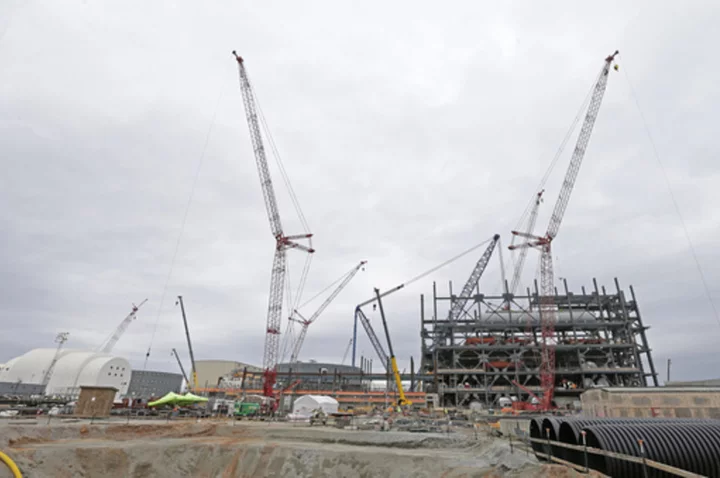WAYNESBORO, Ga. (AP) — The first of two nuclear reactors in Georgia is generating electricity and could be days away from achieving full-power operation. But the new units at Georgia Power Co.'s Plant Vogtle are $17 billion over budget and running seven years late.
Customers of multiple Georgia utilities are already paying billions, although state regulators haven't yet decided how much Georgia Power ratepayers will owe.
Meanwhile, two of the same model reactors that were planned for different owners in South Carolina were abandoned partway through construction. There, federal prosecutors have pursued criminal charges against utility and construction executives, saying they illegally concealed delays and cost overruns.
The projects were supposed to mark a rebirth for the U.S. nuclear industry, but construction proved difficult despite consistent federal support.
Here's a timeline of the two nuclear projects:
1970: Georgia Power Co., a unit of Atlanta-based Southern Co., decides to build four nuclear reactors along the Savannah River bordering South Carolina.
1976: Construction resumes at the plant after two of four reactors are cancelled. It's named for Alvin W. Vogtle, then CEO of Southern Co. During World War II, Vogtle was a fighter pilot who was captured by German fighters and escaped from a prisoner of war camp on his fifth attempt.
1989: Unit 2 finally goes online after Unit 1 entered service in 1987. Originally projected to cost $660 million, the two reactors eventually cost $8.9 billion.
2001: Utilities including Southern Co., the parent of Georgia Power Co., meet with federal regulators to discuss ways to ease permitting for new nuclear power plants, in a push by President George W. Bush's administration.
2004: Southern Co., three other utilities and three nuclear reactor designers including Westinghouse Electric Co. jointly apply for new reactor licenses.
2005: Southern Co. announced that it's evaluating the Vogtle site for new reactors, saying it believes Georgia will need more electrical generation in the future.
2006: Southern Co. picks Westinghouse's AP1000 reactor design and applies for an early site permit days after U.S. Energy Secretary Samuel Bodman promises $2 billion in incentives for new reactors nationwide in a speech at Georgia Power headquarters.
2007: The Georgia Public Service Commission says Georgia Power can build two new reactors at Vogtle, but only if finds no cheaper options. No competing generators offer bids for long-term contracts. Westinghouse signs a contract to build AP1000 reactors in China.
2008: Southern Co. seeks a license for Vogtle from the Nuclear Regulatory Commission. SCANA Corp. also asks to build two new reactors at the V.C. Summer plant near Columbia, South Carolina. Georgia Power asks public service commissioners to approve plans after co-owners Oglethorpe Power Corp., Municipal Electric Authority of Georgia and the city of Dalton join the project. The reactors are supposed to cost $14 billion and be complete by 2017.
2009: The Georgia Public Service Commission approves Georgia Power’s request to begin construction. Weeks later, Georgia Gov. Sonny Perdue signs a law allowing Georgia Power to make customers pay financing costs during construction. Contractors begin moving dirt at Vogtle.
2010: President Barack Obama's administration announces $8.33 billion in loan guarantees for Vogtle, lowering borrowing costs for the owners.
2012: The Nuclear Regulatory Commission approves licenses for Vogtle and Summer. By then, with construction underway, the projects were already running behind.
2014: Problems with modular construction slow the Vogtle and Summer projects, disproving promises that giant Lego-like modules would make building faster, cheaper and produce a higher-quality result.
2015: Georgia Power and plant construction contractors sue each other over delays that add more than $3 billion to the project and three years to the completion date.
2017: Mounting delays and losses lead Westinghouse, then a unit of Japan's Toshiba Corp., to file for bankruptcy. To walk away, Toshiba pays $3.7 billion to the Georgia owners and $2.2 billion to the South Carolina owners. The South Carolina owners abandon construction at Summer after state-owned utility Santee Cooper votes to stop. The Georgia Public Service Commission votes to let work continue at Vogtle as the price tag crosses $25 billion.
2018: The city-owned utility in Jacksonville, Florida, unsuccessfully tries to void its contract to buy Vogtle's power from the Municipal Electric Authority of Georgia. Oglethorpe Power, owned by Georgia electric cooperatives, threatens to pull out and torpedo Vogtle. Oglethorpe relents after Gov. Nathan Deal intervenes and Georgia Power agrees to pay some potential overruns.
2019: The Trump administration finalizes another $3.7 billion in loan guarantees for Vogtle, bringing the total to $12 billion.
2020: The COVID-19 pandemic slows work at Vogtle. Former SCANA Corp. executives begin pleading guilty to federal criminal charges over concealing delays at Summer.
2021: Georgia Power announces a cascading series of four delays, with monitors saying contractors and Southern Co. did sloppy work while rushing to meet an unachievable schedule. The Nuclear Regulatory Commission steps up oversight. Costs to owners exceed $28 billion, double the original estimate.
2022: Georgia Power's co-owners sue, saying the utility is reneging on its contract to shoulder overruns, as costs to owners surpass $30 billion. Georgia Power settles with Municipal Electric Authority of Georgia. Unit 3 begins loading radioactive fuel.
2023: Vogtle's Unit 3 begins generating electricity, with officials saying it may reach full power output by May 27. Unit 4 reaches a key testing phase. Costs to owners reach $31 billion.

